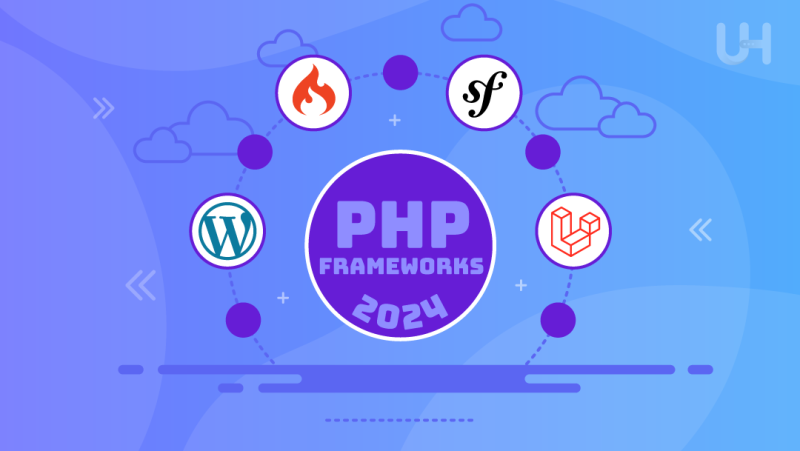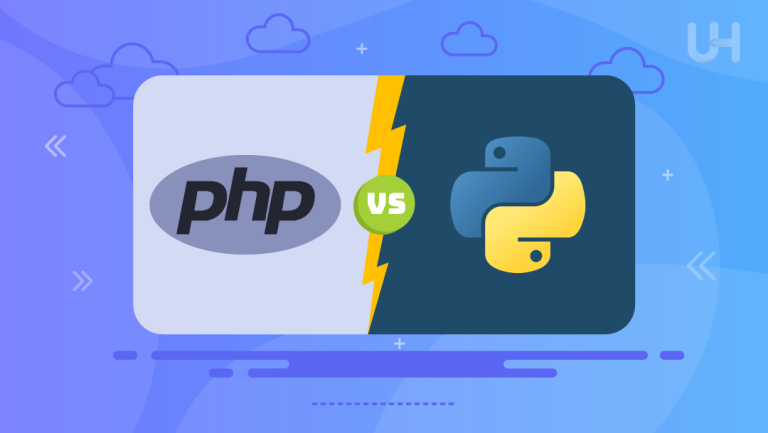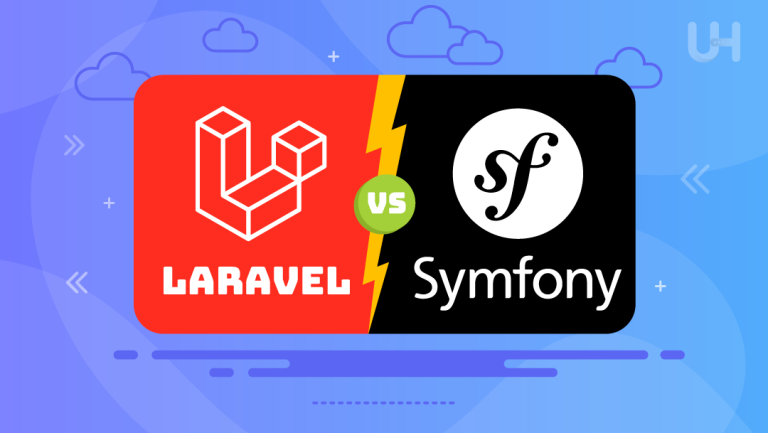PHP Frameworks remains a cornerstone in the world of web development, continuing to power millions of websites and applications since its inception. Over the years, PHP has evolved significantly, incorporating modern programming practices and improving performance, security, and scalability. This evolution has ensured its relevance, even as newer languages and technologies emerge. Today, PHP is more robust than ever, thanks to continuous updates and an active. It is a dedicated community of developers who keep pushing the boundaries of what it can achieve.
In 2024, choosing the right PHP framework is crucial for building efficient, secure, and scalable web applications. Frameworks streamline development processes by providing pre-built modules, libraries, and best practices. Moreover, it enables developers to focus on the unique aspects of their projects. With numerous options available, each offering its unique strengths and features, selecting the best PHP framework can be challenging.
Overview of PHP in Web Development
PHP, originally created by Rasmus Lerdorf in 1994, has a rich history marked by continuous evolution and adaptation. It is initially conceived as a set of Common Gateway Interface (CGI) binaries written in C. At first, PHP was designed to manage personal web pages. Its simplicity and ability to embed directly into HTML quickly gained it a following among early web developers. This early version, known as “Personal Home Page Tools,” laid the groundwork for what would become one of the most influential languages in web development.
Current Trends and Relevance in 2024
Fast forward to 2024, and PHP continues to be a vital part of the web development ecosystem. The language has undergone significant enhancements, particularly with the release of PHP 7 and PHP 8, which introduced major performance improvements and modern features like JIT (Just-In-Time) compilation. These updates have made PHP more efficient and capable of handling high-performance applications, aligning with modern development needs. Moreover, the introduction of PHP 8.x has particularly been a game-changer, offering developers tools to write cleaner, faster, and more secure code.
Current trends in PHP usage highlight its continued relevance and adaptability. One notable trend is the increasing adoption of PHP frameworks, which streamline the development process and enforce best practices. Frameworks like Laravel, Symfony, and CodeIgniter offer pre-built modules, libraries, and robust tools that simplify complex tasks, enhance security, and boost productivity. These frameworks are particularly valued for their ability to speed up development cycles and provide scalable solutions for large projects.
Moreover, PHP’s role in content management systems (CMS) and e-commerce platforms remains strong. Furthermore, popular CMS platforms like WordPress, Drupal and Joomla are built on PHP, making it a crucial skill for developers working in content-driven industries. In e-commerce, platforms like Magento and WooCommerce rely heavily on PHP, demonstrating its capability to handle complex, transaction-heavy applications.
Importance of Using Frameworks
Frameworks play a crucial role in modern web development by providing developers with structured tools and libraries that streamline the creation of web applications. Here’s why frameworks are important and the benefits they offer:
Benefits of Frameworks
- Efficiency: Frameworks offer pre-built modules, components, and libraries that eliminate the need to write repetitive code from scratch. This significantly speeds up the development process, allowing developers to focus more on application logic rather than routine tasks. For example, tasks like user authentication, routing, and database interaction are often handled seamlessly within a framework, reducing development time and effort.
- Security: Many frameworks incorporate built-in security features and best practices to protect against common web vulnerabilities such as SQL injection, cross site scripting (XSS), and cross-site request forgery (CSRF). Frameworks are typically developed with security in mind. Moreover, it ensures that applications built on them are more resistant to attacks compared to custom-built solutions.
- Scalability: Frameworks are designed to support the growth and expansion of applications over time. They often include features like caching, session management, and database connection pooling, which optimize performance and enable applications to handle increased traffic and data volumes efficiently. Moreover, frameworks also encourage the use of scalable architectural patterns such as MVC (Model-View-Controller), which separates concerns and promotes maintainability as applications grow.
Criteria for Selecting a Framework
When choosing a framework for a project, several factors should be considered to ensure it aligns with project requirements and development goals:
- Performance: Evaluate the framework’s performance benchmarks, including response times and resource utilization under load. Furthermore, choose a framework that can handle the expected traffic and data processing demands of the application.
- Community Support: Opt for frameworks with active and supportive communities. A vibrant community ensures ongoing development, timely bug fixes, and a wealth of resources such as documentation, forums, and third-party plugins.
- Learning Curve: Consider the learning curve associated with the framework. Choose one that matches the skills and expertise of your development team or invest in training to ensure efficient adoption.
- Flexibility and Extensibility: Assess how easily the framework can be customized and extended to meet specific project requirements. Look for frameworks that allow plugins, extensions, and integration with third-party services without compromising performance or security.
- Documentation and Support: Good documentation is essential for understanding the framework’s features, APIs (Application Programming Interface), and best practices. Also, ensure that the framework’s documentation is comprehensive, up-to-date, and easily accessible.
- Security Features: Prioritize frameworks that prioritize security and include features like input validation, CSRF protection, and secure session management out of the box. Moreover, this reduces the risk of vulnerabilities in your application.
- Long-Term Viability: Evaluate the framework’s roadmap and community engagement to gauge its long-term viability. Choose frameworks backed by reputable organizations or communities with a track record of continuous development and support.
Ready to Elevate Your PHP Projects?
Start your hosting journey tailored for unparalleled success. Dive deep into the intricate world of PHP hosting with Ultahost, where cutting-edge technology meets reliability. Experience hosting solutions designed to optimize performance!
Laravel
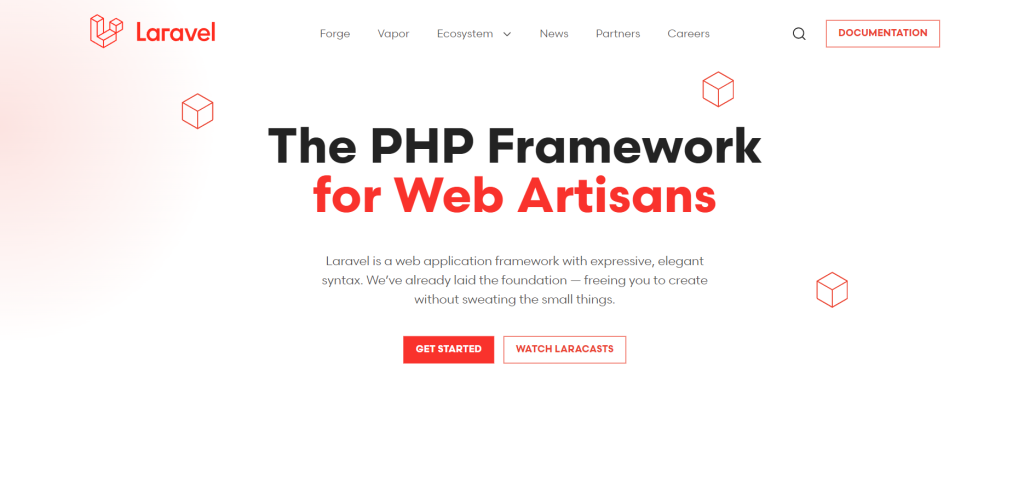
Laravel stands as one of the most popular PHP frameworks, renowned for its elegant syntax, developer-friendly approach, and robust feature set. Developed by Taylor Otwell and released in 2011, Laravel quickly gained traction within the PHP community for its focus on simplicity and scalability. It was created with the goal of making web development enjoyable without sacrificing functionality.
Since its inception, Laravel has evolved through consistent updates and community contributions, becoming a mature and stable framework. Moreover, its active community plays a pivotal role in its growth, providing extensive documentation, tutorials, and third-party packages that enhance its capabilities. Laravel’s ecosystem includes Laravel Forge for server management, Laravel Horizon for queue monitoring, and Laravel Nova for administration panels, reflecting its comprehensive support structure.
Key Features
Laravel is equipped with several powerful features that streamline development and enhance productivity:
- Eloquent ORM: Laravel’s ORM (Object-Relational Mapping) simplifies database operations by allowing developers to work with database records as PHP objects. Moreover, it provides an intuitive syntax for querying databases and defining relationships between database tables.
- Blade Templating Engine: Blade is Laravel’s lightweight templating engine, offering developers a clean, simple syntax for writing dynamic views. It supports template inheritance, components, and includes, making it easy to manage and reuse frontend code.
- Laravel Echo: This feature enables real-time web applications with its built-in support for WebSockets and event broadcasting. Moreover, Laravel Echo simplifies the integration of WebSockets into applications, facilitating features like live chat, notifications, and real-time updates.
Pros and Cons
Strengths:
- Developer-Friendly: Laravel prioritizes developer experience with expressive syntax and built-in tools that reduce boilerplate code.
- Comprehensive Ecosystem: It offers a wide range of official and community-driven packages that extend its core functionality.
- Active Community: Laravel boasts a large and supportive community, ensuring continuous improvement, robust documentation, and ample learning resources.
Potential Drawbacks:
- Learning Curve: Beginners may find Laravel’s rich feature set initially overwhelming, requiring time to grasp its full potential.
- Performance: While Laravel is performant for most applications, extensive use of ORM and other features may impact performance in high-traffic scenarios.
Use Cases
Laravel is ideal for various types of web projects, including:
- Content Management Systems (CMS): Platforms like October CMS are built on Laravel, leveraging its flexibility and ease of customization.
- E-commerce Applications: Laravel’s ORM and robust authentication system make it suitable for developing secure and scalable e-commerce platforms.
- Enterprise Solutions: Large-scale applications benefit from Laravel’s modular architecture, facilitating complex workflows and integrations.
Symfony
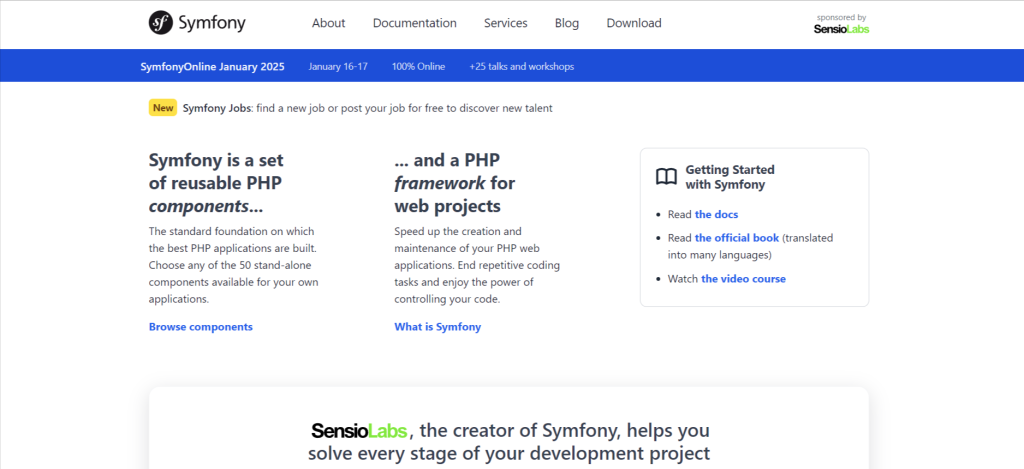
Symfony is a widely acclaimed PHP framework known for its flexibility, scalability, and adherence to best practices in web development. Initially released in 2005 by SensioLabs, Symfony aimed to provide developers with a set of reusable components and tools that streamline the creation of web applications. Over the years, Symfony has garnered a strong following in the PHP community and beyond, particularly in enterprise-level projects where stability and extensibility are paramount.
Symfony’s journey began with the vision of SensioLabs to create a framework that promotes code reusability and maintainability. Moreover, its development has been guided by the Symfony community, which actively contributes to its evolution through feedback, improvements, and the creation of additional components. Symfony’s ecosystem is bolstered by SensioLabs’ commitment to long-term support and regular updates, ensuring compatibility with modern PHP standards and industry trends.
Key Features
Symfony distinguishes itself with several key features that empower developers:
- Twig Templating Engine: Symfony adopts Twig as its default templating engine, offering a clean, secure, and efficient way to design dynamic views. Twig’s syntax is intuitive and promotes separation of concerns, enhancing code readability and maintainability.
- Symfony Flex: Introduced in Symfony 3.3, Symfony Flex is a modern replacement for the Symfony Standard Edition. It automates the installation and configuration of Symfony applications and bundles, streamlining setup and reducing boilerplate code.
- Extensive Components: Symfony is renowned for its robust collection of reusable components, which cover a wide range of functionalities such as HTTP handling, form creation, security, and caching. Moreover, these components can be used independently or integrated seamlessly within Symfony applications, offering flexibility and scalability.
Pros and Cons
Strengths:
- Modular Architecture: Symfony’s modular architecture allows developers to use only the components they need, promoting code reusability and reducing dependency on external libraries.
- Stability and Long-Term Support: Symfony provides long-term support (LTS) releases. Moreover, it ensures backward compatibility and security updates for extended periods.
- Enterprise-Ready: Symfony’s emphasis on best practices, scalability, and extensibility makes it suitable for building complex, high-traffic applications.
Potential Drawbacks:
- Learning Curve: Due to its comprehensive feature set and modular approach, Symfony may have a steeper learning curve compared to more lightweight frameworks.
- Configuration Overhead: Setting up Symfony applications initially may require configuring multiple components and understanding Symfony’s conventions, which can be daunting for beginners.
Use Cases
Symfony is well-suited for a variety of projects, including:
- Enterprise Applications: Symfony’s stability, scalability, and comprehensive feature set make it an ideal choice for large-scale enterprise applications requiring robust security and performance.
- API Development: Symfony’s HTTP handling components and RESTful API capabilities are well-suited for developing scalable and efficient APIs.
- Content Management Systems (CMS): Platforms like eZ Platform leverage Symfony components for creating customizable and extensible content management solutions.
CodeIgniter
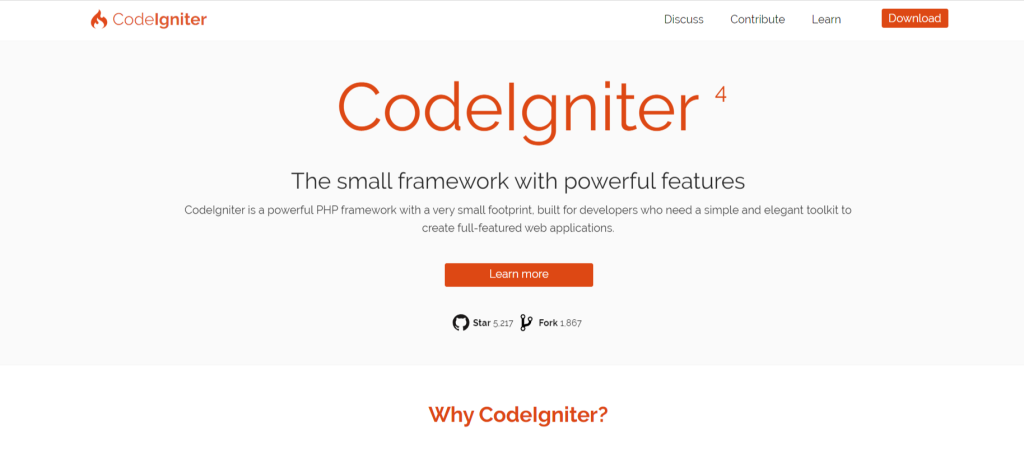
CodeIgniter, launched in 2006 by EllisLab, has established itself as a lightweight yet powerful PHP framework. It gained popularity for its simplicity, ease of use, and rapid development capabilities, making it a preferred choice for developers who prefer using a fast VPS server and prioritize efficiency and minimal configuration overhead. Moreover, CodeIgniter’s approachable learning curve and emphasis on straightforward implementation have contributed to its enduring appeal in the PHP community.
Initially developed as an alternative to the then-popular PHP frameworks, CodeIgniter aimed to simplify web application development without imposing rigid coding conventions. Moreover, CodeIgniter has evolved under community after EllisLab handed over its development to the community in 2014. Despite its change in ownership, CodeIgniter maintains a dedicated user base and active community support, ensuring ongoing updates, documentation improvements, and third-party contributions.
Key Features
CodeIgniter distinguishes itself with several key features tailored for rapid development:
- Lightweight: CodeIgniter is known for its small footprint and minimal server requirements, making it suitable for hosting environments with limited resources.
- MVC Architecture: Following the Model-View-Controller (MVC) architectural pattern, CodeIgniter promotes the separation of concerns, enhancing code organization and maintainability. Moreover, developers can easily manage application logic, presentation, and data storage independently within the MVC structure.
- Ease of Use: CodeIgniter prioritizes simplicity and straightforward implementation. Its clear documentation and intuitive syntax enable developers to quickly grasp core concepts and start building applications efficiently.
Pros and Cons
Strengths:
- Simplicity and Rapid Development: CodeIgniter’s lightweight nature and straightforward setup allow developers to start coding quickly without complex configuration or steep learning curves.
- Flexibility: It offers a good balance between structure and flexibility. Moreover, it allows developers to adopt MVC patterns while adapting to project-specific requirements.
- Community and Support: CodeIgniter maintains a supportive community and active user forums, ensuring assistance and resources for developers.
Potential Drawbacks:
- Limited Built-in Features: CodeIgniter may have fewer built-in features and libraries, requiring developers to rely more on third-party extensions for complex functionalities.
- Scalability: CodeIgniter’s lightweight design may pose challenges in scaling larger applications without careful planning.
Use Cases
CodeIgniter is well-suited for various types of projects, including:
- Prototyping and MVPs: Its rapid development capabilities make CodeIgniter ideal for building prototypes and minimum viable products (MVPs) quickly.
- Small to Medium-Sized Applications: CodeIgniter’s lightweight footprint and simplicity make it suitable for developing blogs using affordable blog hosting, content management systems (CMS), and e-commerce platforms.
- Legacy System Maintenance: It is effective for maintaining and extending existing PHP applications due to its minimalistic approach and backward compatibility.
Yii
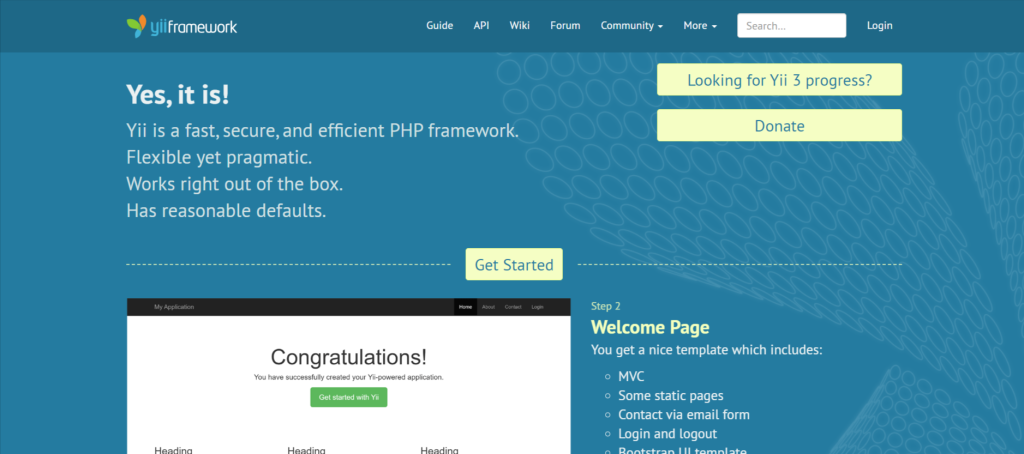
Yii (pronounced as “yee”) stands out as a high-performance PHP framework known for its efficiency, security, and extensibility. Initially released in 2008 by Qiang Xue, Yii has gained popularity among developers who prioritize performance and rapid development without compromising on security features. The name “Yii” stands for “Yes It Is,” reflecting its straightforward and declarative approach to web application development.
Yii was developed with the goal of other PHP frameworks, focusing on performance optimizations and a robust set of features out of the box. Moreover, Yii has garnered a strong community following, supported by active contributors who enhance its core functionalities and expand its ecosystem with plugins and extensions. Yii’s commitment to backward compatibility and regular updates ensures it remains relevant in the evolving landscape of web development.
Key Features
Yii offers several key features that cater to developers seeking performance and security:
- Performance: Yii is renowned for its high-performance capabilities, leveraging lazy loading and efficient caching mechanisms to optimize application speed and response times, even under heavy loads.
- Gii Code Generator: Gii is Yii’s powerful code generation tool that automates repetitive tasks, such as CRUD (Create, Read, Update, Delete) operations and model creation. Moreover, it accelerates development cycles by generating boilerplate code based on database schemas, reducing manual coding efforts.
- Security Features: Yii prioritizes security with built-in measures against common web vulnerabilities. It includes SQL injection, cross-site scripting (XSS), and CSRF attacks. Moreover, it provides robust authentication and authorization mechanisms, session management, and data validation to safeguard applications.
Pros and Cons
Strengths:
- Performance Optimization: Yii’s efficient caching, lazy loading, and optimized database queries contribute to superior performance. Therefore, it makes it suitable for high-traffic applications.
- Security Focus: Its built-in security features and adherence to best practices ensure applications developed with Yii are resilient to common web threats.
- Extensibility: Yii’s modular architecture and support for extensions allow developers to customize and extend core functionalities easily. Moreover, it adapts the framework to project-specific requirements.
Potential Drawbacks:
- Learning Curve: Yii may have a moderate learning curve for beginners due to its comprehensive feature set and configuration options.
- Documentation: While Yii offers extensive documentation, some developers may find it less accessible compared to other frameworks.
Use Cases
Yii is well-suited for various types of projects, including:
- Enterprise Applications: Its performance optimizations and security features make Yii ideal for developing robust enterprise-level applications handling sensitive data and complex business logic.
- Content Management Systems (CMS): Platforms like Craft CMS utilize Yii for their backend infrastructure, benefiting from Yii’s scalability and customization capabilities.
- E-commerce Solutions: Yii is suitable for building secure and scalable e-commerce platforms that require efficient handling of transactions and user interactions.
Ready to Elevate Your Web Development?
Choose the best PHP framework for your project and pair it with reliable hosting. Visit Ultahost eCommerce Hosting for top-notch hosting solutions that ensure your applications run smoothly and efficiently. Get started today!
CakePHP
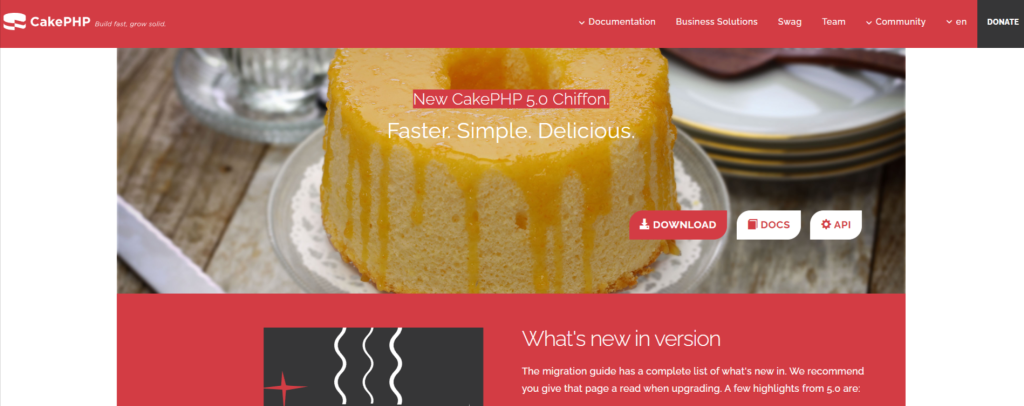
CakePHP is a powerful PHP framework known for its simplicity, rapid development capabilities, and adherence to the “convention over configuration” principle. Initially released in 2005 by Cake Software Foundation, CakePHP has a strong following in the PHP community for its intuitive approach to building web applications. Moreover, it aims to streamline development by reducing repetitive tasks and allowing developers to focus more on application logic.
CakePHP was developed to simplify web application development by adopting conventions that eliminate the need for extensive configuration. CakePHP’s community-driven approach ensures that it remains relevant and responsive to the evolving needs of developers.
Key Features
CakePHP offers several key features designed to enhance productivity and maintainability:
- Convention over Configuration: CakePHP follows a set of conventions that minimize the need for configuration, such as naming conventions for files and database tables. Moreover, this approach accelerates development by reducing the amount of boilerplate code typically required in PHP applications.
- ORM (Object-Relational Mapping): CakePHP’s ORM simplifies database interactions by mapping database tables to PHP objects. It supports CRUD operations and allows developers to define relationships between database tables using straightforward PHP syntax. Moreover, it promotes code readability and maintainability.
- Scaffolding: CakePHP provides scaffolding features that generate basic CRUD functionality for models and controllers automatically. This scaffolding can be customized to fit specific project requirements, allowing developers to quickly prototype and iterate on application features.
Pros and Cons
Strengths:
- Rapid Development: CakePHP’s convention over configuration and scaffolding features enable rapid prototyping and development of web applications.
- Simplicity: Its intuitive design and clear documentation make CakePHP accessible for developers of varying skill levels, facilitating quick adoption and productivity.
- Community Support: CakePHP benefits from a dedicated community that contributes plugins, extensions, and resources to enhance its functionality and address specific use cases.
Potential Drawbacks:
- Flexibility vs. Convention: While conventions simplify development, they may limit flexibility in certain scenarios where custom configurations are necessary.
- Performance: Compared to some other frameworks, CakePHP may require optimization for handling extremely high-traffic applications due to its convention-based approach.
Use Cases
CakePHP is suitable for various types of projects, including:
- Prototyping and MVPs: Its scaffolding and rapid development capabilities make CakePHP ideal for quickly prototyping minimum viable products (MVPs) and testing concepts.
- Content Management Systems (CMS): Platforms like Croogo CMS utilize CakePHP for their backend infrastructure. Moreover, they benefit from its modular architecture and ease of customization.
- E-commerce Solutions: CakePHP is effective for developing e-commerce platforms. It requires efficient management of product catalogs, customer accounts, and transaction processing.
Phalcon
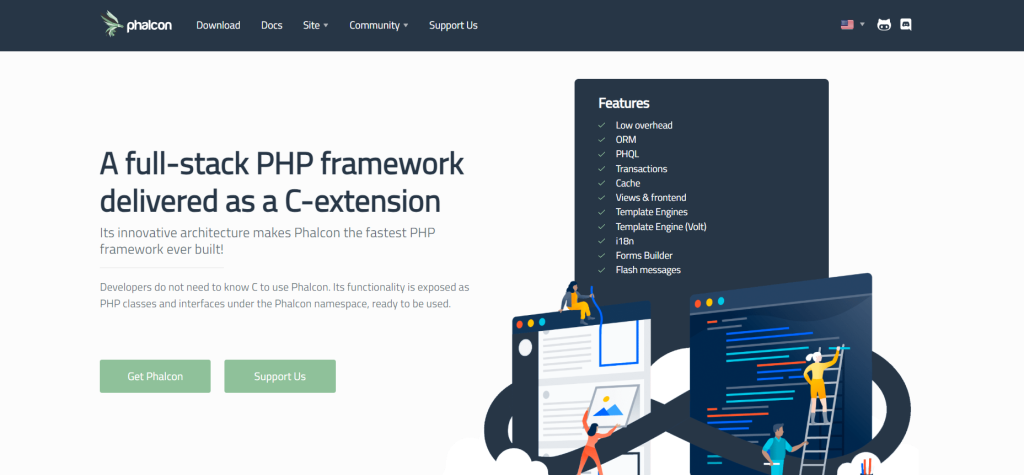
Phalcon is a unique PHP framework recognized for its exceptional performance, low overhead, and innovative architecture. Unlike traditional PHP frameworks that are purely written in PHP, Phalcon is implemented as a C-extension. Moreover, it provides higher efficiency and reduced resource consumption. Released in 2012 by Phalcon Team, Phalcon quickly gained attention in the PHP community for its speed and ability to handle complex tasks efficiently.
Phalcon was conceived to address performance in PHP frameworks by leveraging C-extension technology. Its development has been driven by the Phalcon Team and a dedicated community of contributors who enhance its capabilities, provide support, and develop extensions. Moreover, Phalcon maintains the PHP standards and continues to evolve with regular updates and improvements.
Key Features
Phalcon sets itself apart with several key features tailored for performance and efficiency:
- C-Extension Based: Phalcon’s core components are implemented as a C-extension to PHP. Moreover, it significantly boosts performance and reduces overhead compared to frameworks written purely in PHP.
- High Performance: Phalcon achieves superior performance in handling HTTP requests, database interactions, and other critical operations. Therefore, it is suitable for high-traffic applications.
- Low Overhead: Phalcon’s architecture minimizes resource consumption by offloading intensive tasks to its C-extension core. Therefore, resulting in faster response times and reduced server load compared to traditional PHP frameworks.
Pros and Cons
Strengths:
- Exceptional Performance: Phalcon’s C-extension architecture ensures fast execution speeds and efficient resource utilization. Moreover, it is ideal for applications requiring high performance and scalability.
- Low Overhead: Its reduced resource consumption and efficient memory management contribute to improved server responsiveness and lower operational costs.
- Innovative Architecture: Phalcon’s unique approach to leveraging C-extension technology provides developers with a powerful toolset for building complex applications efficiently.
Potential Drawbacks:
- Learning Curve: Phalcon’s unconventional architecture and advanced features may pose a learning curve for developers accustomed to traditional PHP frameworks.
- Limited Hosting Support: Some hosting providers may have limitations or require specific configurations to support Phalcon due to its C-extension nature.
Use Cases
Phalcon is well-suited for various types of projects, particularly those requiring high performance and low overhead, including:
- Real-Time Applications: Its speed and efficiency make Phalcon suitable for developing real-time applications such as chat platforms, streaming services, and financial trading systems.
- API Development: Phalcon’s performance and RESTful API capabilities are ideal for building scalable and efficient API-driven applications.
- High-Traffic Websites: Phalcon’s ability to handle requests and intensive data processing tasks makes it suitable for websites and applications with heavy user traffic and data interactions.
FuelPHP
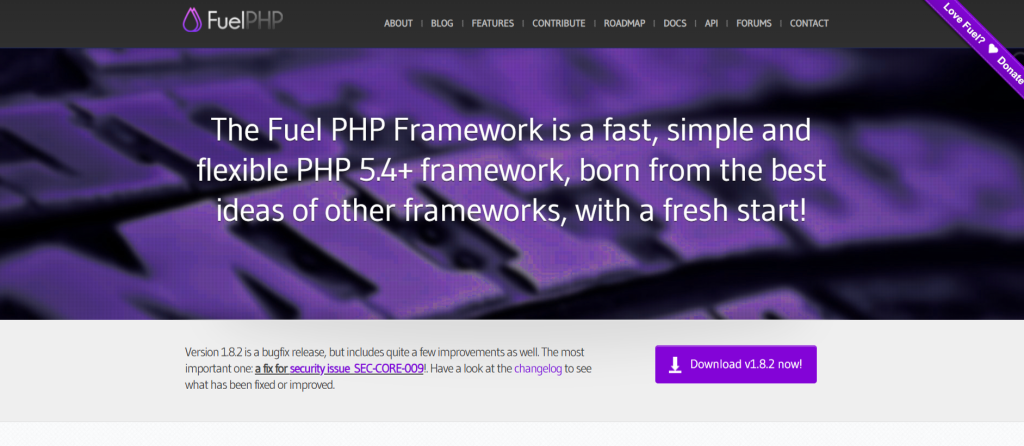
FuelPHP is a full-stack PHP framework known for its modular architecture, HMVC (Hierarchical Model-View-Controller) design pattern, and emphasis on security. Initially released in 2011, FuelPHP was developed to provide developers with a flexible and efficient framework for building web applications. While not as widely adopted as some other PHP frameworks, FuelPHP has a dedicated following among developers who appreciate its modular approach and robust feature set.
FuelPHP was created by Dan Horrigan and a team of developers who aimed to combine the best practices of existing PHP frameworks with innovative features. Moreover, its development has been driven by a community of contributors who ensure ongoing updates and support through active forums. Despite its smaller community compared to other frameworks, FuelPHP continues to evolve with regular releases and improvements.
Key Features
FuelPHP offers several key features designed to enhance flexibility, security, and development efficiency:
- Full-Stack Framework: FuelPHP provides a comprehensive suite of tools and libraries for both backend and frontend development. Moreover, it facilitates full-stack web application development.
- HMVC Architecture: FuelPHP adopts the HMVC design pattern. Therefore, it allows developers to organize application logic into modules, each with its own MVC triad (Model-View-Controller). This modular approach promotes code reusability, separation of concerns, and scalability.
- Security Features: FuelPHP incorporates built-in security measures to protect against common web vulnerabilities. It includes XSS (Cross-Site Scripting), CSRF (Cross-Site Request Forgery), and SQL injection attacks. Moreover, it provides robust input filtering, output escaping, and authentication mechanisms to safeguard applications.
Pros and Cons
Strengths:
- Modular Architecture: FuelPHP’s HMVC architecture promotes code organization, reusability, and scalability, making it suitable for complex web applications.
- Security Focus: Its built-in security features and best practices help developers mitigate common security threats. Moreover, it ensures the integrity and confidentiality of application data.
- Flexible and Extensible: FuelPHP’s modular design and support for third-party extensions. Moreover, it allows developers to customize and extend core functionalities according to project-specific requirements.
Potential Drawbacks:
- Learning Curve: Developers unfamiliar with HMVC or modular architectures may face a learning curve when starting with FuelPHP.
- Community Size: FuelPHP’s smaller community may result in fewer third-party plugins, extensions, or community-generated resources.
Use Cases
FuelPHP is well-suited for various types of projects, including:
- Content Management Systems (CMS): Its modular architecture and full-stack capabilities make FuelPHP suitable for developing customizable and extensible CMS platforms.
- Enterprise Applications: FuelPHP’s HMVC pattern and security features cater to building scalable and secure enterprise-level applications. Moreover, it handles sensitive data and complex business logic.
- Custom Web Applications: It is effective for developing bespoke web applications requiring flexibility, modularity, and advanced security measures.
Conclusion
In conclusion, choosing the right PHP framework in 2024 hinges on understanding each option’s unique strengths. Laravel excels with its elegant syntax and extensive ecosystem, suitable for projects of all sizes. Moreover, Symfony offers flexibility and stability, ideal for complex, scalable applications.
CodeIgniter remains a go-to for simplicity and rapid development. Yii impresses with performance and security features, while Phalcon stands out for its high performance and low overhead. Moreover, FuelPHP’s modular architecture and security focus make it versatile for various project needs. Each framework reviewed here offers distinct advantages, ensuring developers can find the right fit for their specific requirements in today’s dynamic web development landscape.
Choosing the right PHP framework is essential for successful web development. For optimal performance and support, consider pairing your framework with top-notch hosting. Check out Ultahost Envato Hosting for reliable hosting solutions tailored to your needs.
FAQ
What should I consider when choosing a PHP framework?
Consider factors like project complexity, developer familiarity, community support, performance needs, and framework features to align with project requirements effectively.
Which PHP framework is best for beginners?
Laravel and CodeIgniter are great for beginners due to their user-friendly syntax, comprehensive documentation, and supportive communities.
How can I ensure compatibility with future PHP updates?
Choose frameworks that adhere to PHP standards and offer regular updates and long-term support plans, ensuring compatibility with future PHP versions.
What are the advantages of using a PHP framework over raw PHP?
Frameworks offer built-in security, standardized coding practices like MVC, code generation tools for faster development, and robust community support, enhancing scalability and maintainability.
How do I migrate between PHP frameworks?
Migrating involves code refactoring, data migration, and adjusting server configurations. Engage experienced developers and leverage migration tools to streamline the process.





